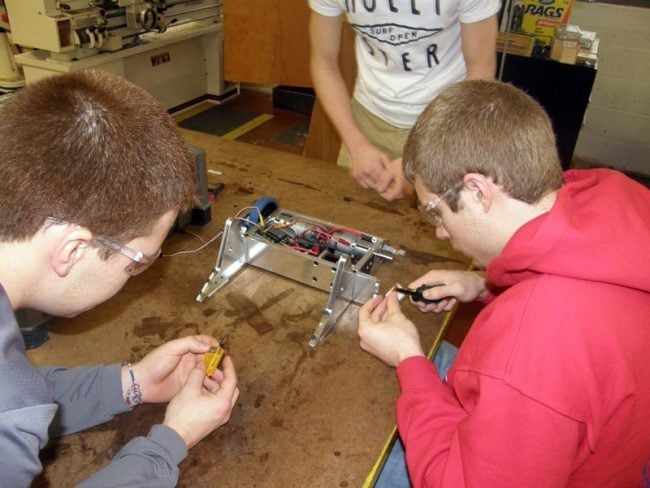If you remember BattleBots from television a few years back, you'll love the work that Chris Yost, Technology and Engineering Instructor at Cochranton HS, in Cochranton, PA, is doing.
Chris is an organizer, advisor, board member, and instructor with the NTMA Education Foundation and the RoboBOTS robotics competition. Robobots is a design-, engineering-, and manufacturing-based competition where students use real-world skills, such as parametric modeling and design, problem solving, CNC machining, manual machining, DC electronics, teamwork, science, mathematics, and 3D printing, to build combating robots. With over 41 schools in participation, the competition has grown since 2005, and Chris has seen several different types of 15-lb robots emerge. "Students at Cochranton started with a small 'RamBot' - it's main purpose was to push the other robots around. This year the students produced three 'DrumBots,' which have spinning drums that weigh anywhere from three to five pounds and spin in excess of 10,000 RPM." The competition regulations are tight, so Chris' teams use Solidworks to apply various materials to parts, such as 6061-T6 aluminum or titanium. He says, "Based upon the density of that material and the volume of the part, the program will tell us its final weight accurate to 0.1 grams," before they begin prototyping and milling. The projects use the PCNC 770 for prototyping and end-use robotics parts. "We start with a basic solid model in Solidworks and generate .IGES file or a .DXF files that we then import into MasterCAM. We then generate tool paths and export the G-CODE," Chris says. "I start the students that are new to CNC with monitoring the program to see what the lines of code are 'saying' to the machine, and describe what is happening as it happens. That way, when we get to writing the program, they will go, 'ahh, that's why it was doing that.'" In the past, Chris' student used manual vertical mills, manual lathes, and had assistance through local tool and die shops in town. Using the Tormach "in just the last 2 months, we have increased production in the school by 3 fold. We are actually 3 weeks ahead of our schedule from previous years, in terms of the competition," he explains. "Tormach gave our program the technological edge that we needed to get these kids ready for jobs that are in our area." As always seems to be the case with learning new equipment, adopting the Tormach presented some challenges to the students. The students had difficulty using MasterCAM and having to manually edit code to match a tool number to pick up the tool offset, but Tormach support helped remedy the situation. Chris' teams and students are also making good use of Tormach's tooling and accessories to develop their warring robots. "We have integrated the LED light ring for better vision when edge finding," he explains. They utilize Tormach's Superfly Cutter for surfacing large pieces of aluminum and 4010 steel. "We also opted for the Tormach Machine controller and shuttle jog for the NC code and machine movements." "The most useful part of the Tormach equipment we are using at the moment would have to be the mill itself," Chris says. The students have taken to using the Tormach hardware with ease, and they "are hoping in the next year or two to upgrade to a pneumatic tool change and hopefully secure a grant for a fog-mister or coolant system." Chris explains that the Tormach equipment has helped change how his students approach the building of their robots. "As an instructor I am always looking for new ways to spark innovation within the classroom, but still meet the needs of employers in our local area. Tormach has helped me do this."


